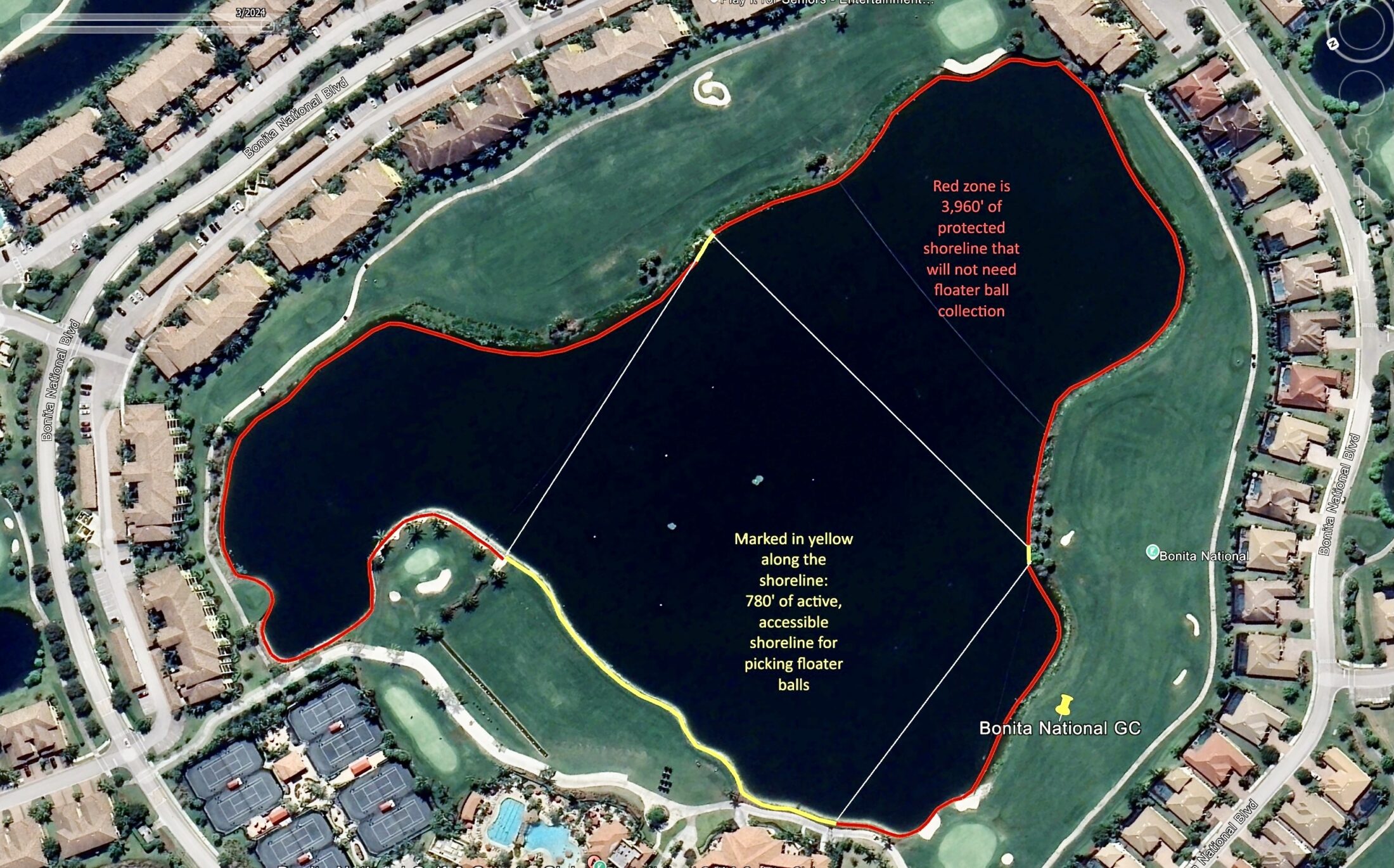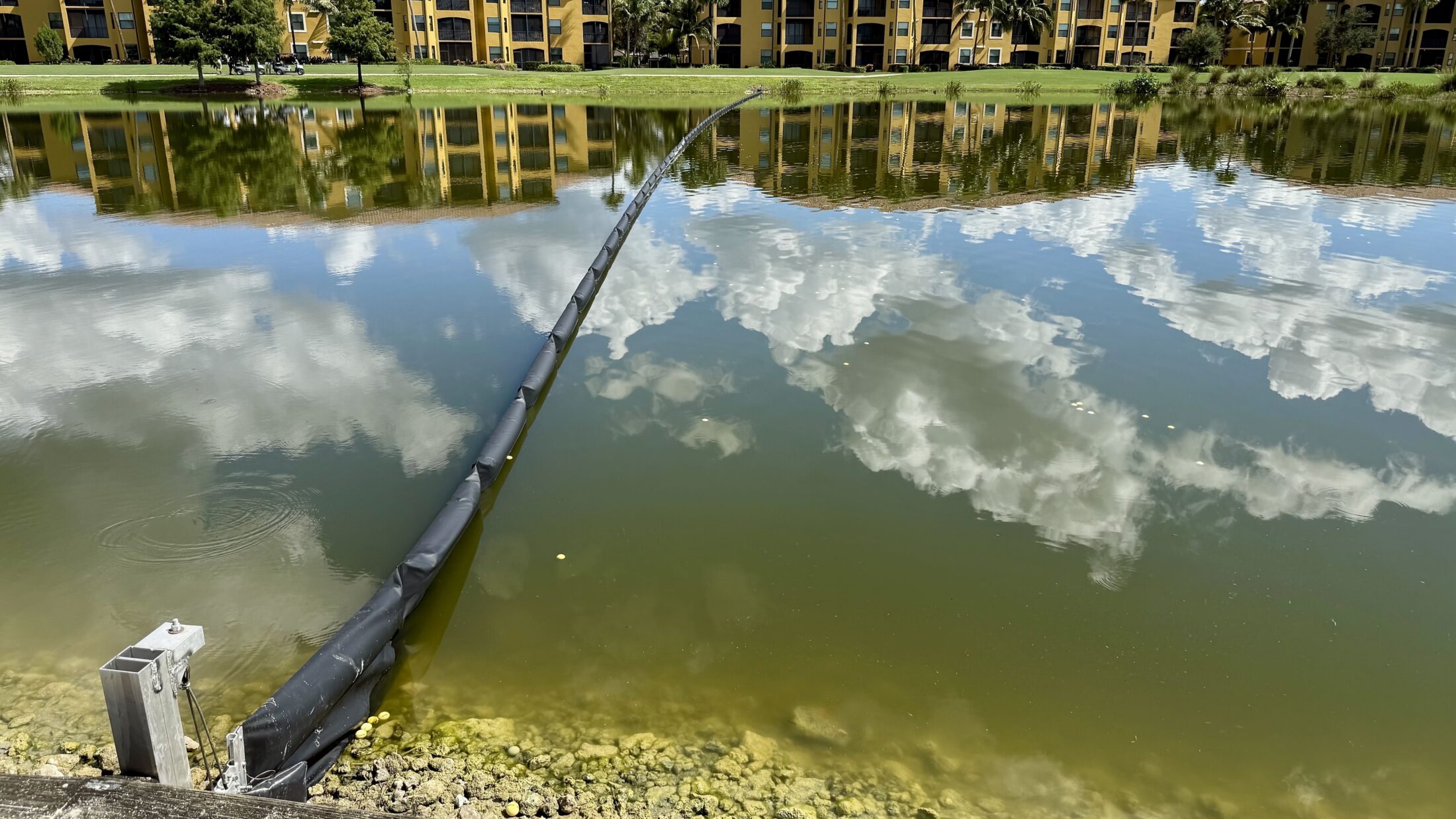By Dave Allen
Earlier this year, Bonita National Golf & Country Club hired some temp laborers to retrieve as many floating golf balls as they could find along the banks of their aqua range—nearly one mile of shoreline (4,740 feet). They removed roughly 45,000 floater balls.
“That’s a lot of golf balls,” says Simon Coulls, general manager of Bonita National, located approximately 15 miles southeast of Fort Myers Beach in Bonita Springs, Fla.
The sheer number of balls (roughly 3,750 dozen) underscores the value of having a floater ball containment system with any aqua range. This particular barrier system, which was installed a year after the course opened in 2014, was severely damaged by hurricanes Irma (2017) and Ian (2022), and was patched together after both with however many usable pieces remained. Had there not been any containment system in place, thousands and thousands more balls would’ve made their way into the high, thick weeds or been lost forever in the mud along the banks.
“That’s a heck of a lot of money tied up into the weeds,” says Matt Gault, whose company, Aqua Greens, built and installed the original aqua range and floating barrier system at Bonita National. “It’s also a huge labor suck for the club, because someone has to walk all that shoreline and scoop up the balls, and it’s much harder to get to the balls if they’re in the native wetlands. Not to mention it’s dangerous because it’s prime alligator and snake territory. It’s a huge labor and ball expense.”
The purpose of a barrier system is twofold: 1) Protect your inventory from washing away downstream or, in Bonita National’s case, getting lost in the weeds; and 2) to save the aforementioned labor costs. The system funnels balls to three or four accessible areas of the range where the balls are easy to pick up, such as the bulkhead at the front of the range.
“You add a containment system, and you’re reducing the amount of shoreline [to be picked] by 60, 70 percent,” Gault says. “Now, your entire shoreline isn’t full of floater balls.”
In addition to building and installing three new target greens last month, including a 20’ x 26’ green with Bonita National’s shield logo stenciled into the surface of the green, Gault and his team also installed a brand new 2,100-foot containment system. The barrier system, which is made of closed-cell polystyrene foaming and UV-resistant, PVC fabric (“Think of a pool noodle on steroids,” Gault says), sits six inches above the water and 12 inches below the surface, so that no balls can escape without a little help from Mother Nature (below, third image). The tubing is tethered into the ground along the shoreline in several places, then towed out into the water by boat (above, main image).
How the system is laid out depends on a number of influences, says Gault, including the prevailing wind and the composition of the shoreline. A rocky shoreline or one with tall vegetation makes it much more difficult to pick up the balls.
This particular barrier system at Bonita National protects more than 80 percent (3,960 feet) of the shoreline. Workers only have to patrol 780 feet of the banks to pick up balls (below, first and second images). There’s also another 300 feet of barrier located to the left of the main teeing area to help contain those balls that might overshoot the green in the short-game practice area.
Hurricane Irma came ashore just south of Naples, Fla., with wind gusts measured as high as 140 miles per hour. While slightly weaker than Ian, which made landfall near Fort Myers Beach as a high-end Category 4 storm with winds gusts eclipsing 150 mph, Irma completely ripped apart the original containment system. Most of it was carried to one corner of the range, and some of it even got wrapped up in the trees like tissue paper on Halloween. Aqua Greens pieced it back together as best they could, and then repeated the same process after Ian three years ago.
Fortunately for Bonita National, they had reserved enough funding to replace the containment system and add three additional target greens. Many of the aqua ranges Gault has built and installed, which numbers more than 100 in Southwest Florida, don’t even have containment systems in place. That’s not good business, according to Gault.
“A lot of them are missing the boat,” Gault says. “They’re basically robbing themselves because they’re constantly battling their facility to get their floater balls back. In most cases, they don’t get them back right away. They’re having to buy new balls all the time, and on top of that they have to pay someone to walk all that shoreline.”
For more information about Aqua Greens’ products and services, which includes custom-designed floating target and island greens, floating barriers and floater balls, visit aquagreens.com or call 1-800-884-4882.





